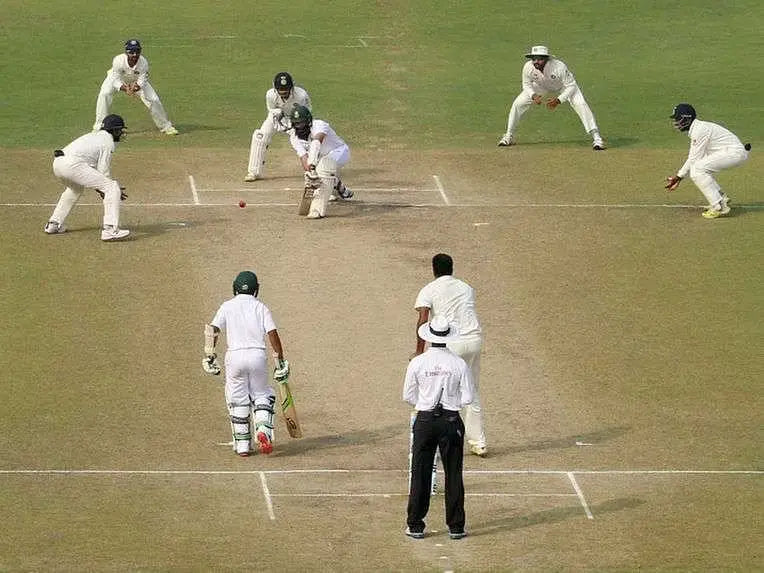You must have often seen fielders deployed very close to the pitch in a test match. This fielding setup is called an attacking cricket field setting and is a crucial part of the game's strategy, although it comes with its risks. Being so near to the action puts the fielders in danger of being hit by powerful shots from the batsman and taking up a severe injury. However, it's a risk worth taking because this aggressive fielding setup aims to create pressure on the batsman, forcing them into errors. Let’s decode this strategy in this article by ZAP and learn how you can set up an attacking field to put the batsman under a lot of pressure and get his wicket.

What is the strategy behind the attacking cricket fielding setups?
Attacking cricket fielding setups are most commonly done in test matches, but are also a part of strategy in ODIs and T20s. They are usually used during a spin bowling spell and are best when the pitch is dried or dusted and offers a good amount of turn and bounce. The main idea behind such a fielding setup is that by having fielders close in, it becomes harder for the batsman to score runs easily. They might feel the pressure to play defensively, which could lead to them making mistakes and getting out. With fielders so close, it is difficult for them to find gaps and score runs freely. With fielders in close proximity, the batsman might feel the need to take more risks, which can increase the likelihood of them making mistakes and getting out. Also, when fielders are set close to the batter, there’s a lot of this tactic is excellent to frustrate the batsman and force them into making mistakes.
Also Read: Cricket Rules
How do you set up an attacking field setting in cricket?
In test matches, the most common attacking fielding setup is where there are 2-3 slips, a fielder placed at the silly point fielding position, and one at the short leg position, all this during a spin bowler’s spell. The main idea is that if the ball turns and the batsman is unable to judge the turn and bounce of the spinning delivery, even the slightest of edges or a mistimed shot can end up in the hands of the fielder placed close to the pitch. During this time, it’s super important for the captain, the fielders, and the bowlers to be in sync with the strategy and the overall play. For example, if the plan is to make the batsman defend the deliveries on his front foot and wait until he makes a mistake or loses patience, the bowler needs to maintain his line and length accordingly. If the execution is not on point, it’ll get easier for the batsmen to counter the pressure and bat freely. While placed close to the fielder, you'll need excellent reflexes and fielding techniques. So work on your technique and reflex training to build important skills to grab onto any difficult catches.
For fast bowlers, things get more difficult. When the leather ball is new and swinging big, the slip fielders and the wicket keepers have a lot of responsibility to grab onto the catches that come off the edge of the bat while the batter is trying to drive or defend the ball.
Also Read: Swing Bowling in Cricket
With an old ball for a fast bowler, it comes down more to strategy than the skill over the bowler to bowl swinging deliveries. A short ball strategy can help wonders. Bowling a short delivery while keeping a fielder at short leg, one at fine leg, one at mid-wicket, and one or two fielders deep at the boundary can be a lethal strategy.
Also, during all of this, it is important to keep the overall fielding balanced. Effective fielding requires striking a balance between aggression and conservatism, knowing when to press for wickets and when to contain runs.
What are the common Attacking Cricket Fielding Positions?

Slips:
This fielding position is generally reserved for the best fielders on the field. Fielders in these positions stand alongside the wicket keeper on both sides of the pitch, leg and off. Only fielders with great reflexes can stand on the slips and take brilliant catches.
Silly Point:
The Silly Point fielding position in cricket is named for its proximity to the batsman and the perceived riskiness of standing there. Positioned close to the batsman on the offside, the silly point is used by the fielding captain to apply pressure on the batsman by limiting their ability to rotate the strike and forcing them into making mistakes. Fielders in this position must be agile, athletic, and fearless, as they face the risk of being hit by the ball, often at high speeds. They need excellent reflexes to react quickly to balls coming their way. Despite the protective gear worn, injuries are common due to the force of impact.
Short Leg:
Short leg is another close-in fielding position in cricket, situated near the batsman on the leg side. Like the silly point, it's used to pressure the batsman and requires alertness, agility, and courage despite the risk of being hit by the ball.
Silly Mid On and Mid Off:
Silly mid-off and silly mid-on are fielding positions close to the batsman on the off side and leg side respectively. They are attacking fielding positions used to create chances when the batsman mistimes their shots. Silly mid-off is straighter than silly point, while silly mid-on is straighter than short leg. Both positions are crucial for catching balls hit straight by the batsman.
Conclusion:
An attacking fielding setup can give the team crucial breakthroughs and tells us how just skills are not enough to dominate the game, but strategy plays an equal part too in winning matches. While fielding at an attacking position, fielders need to develop their reflexes by doing reflex training in the daily cricket workouts. They also have to try and keep themselves safe from any kind of blow against the leather ball off of the batsman’s stroke.
Now that you have read about the attacking cricket fielding position, here are some more articles we recommend you read:
Cricket Exercises | Fast Bowling Exercises | Power hitting in cricket



Share:
Brian Lara - Career, Stats and Records | Highest Score in Test Cricket
Exploring the Essentials: What Goes Inside a Cricket Kit Bag?